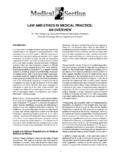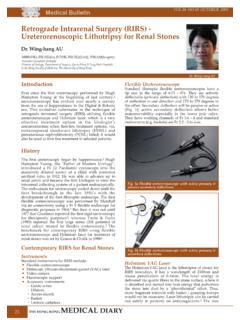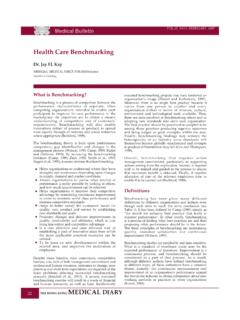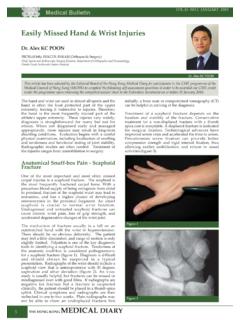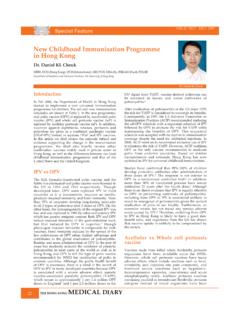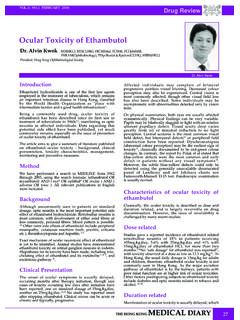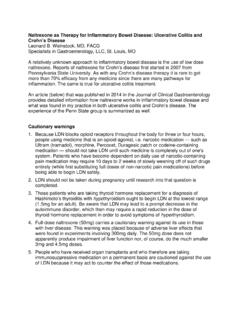Transcription of An Update on Immunosuppressive Medications in …
1 An Update on Immunosuppressive Medications in transplantation Dr. Lui Sing-Leung Division of Nephrology, University Department of Medicine, Queen Mary Hospital and Tung Wah Hospital Introduction Successful organ transplantation requires the use of Immunosuppressive drugs to prevent the host's immune system from rejecting the transplanted organ. Over the past 40 years, Immunosuppressive drugs used in clinical transplantation have evolved greatly. During the 1960s and 70s, corticosteroids and azathioprine were the basis of Immunosuppressive therapy for organ transplantation . This period was characterized by high incidence of acute rejection and low graft survival rate.
2 The introduction of cyclosporine A in the 1980s represented a major advance in Immunosuppressive therapy and substantially improved the 1-year graft survival rate. The so call triple Immunosuppressive regimen, consisting of corticosteroids, azathioprine and cyclosporine A, became the standard Immunosuppressive protocol for many transplant centers throughout the world. The past 10 years saw the addition of a number of new agents to the armamentarium for immunosuppression, which include a microemulsion formulation of cyclosporine A, tacrolimus, mycophenolate mofetil, rapamycin, daclizumab and basiliximab. Moreover, the recent explosion in our understanding of the cellular and molecular mechanisms involved in the immune response against a transplanted organ has led to the development of several novel Immunosuppressive agents.
3 The aim of this article is to provide an Update on the established and recently approved Immunosuppressive drugs in clinical transplantation and to discuss the future trend of Immunosuppressive strategies. Mechanism of Graft Rejection In order to understand how various Immunosuppressive drugs work, some familiarity with the molecular events involved in the immune response leading to the rejection of a transplanted organ is required. The immune response can be conceptualized as consisting of 3 distinct signals1 and is shown diagrammatically in Figure 1. The engagement of the T cell receptor (TCR) with the antigenic peptide in the context of self-major histocompatibility complex (MHC) class II molecule provides signal 1.
4 Antigen recognition leads to the activation of the calcineurin pathway and results in the induction of a number of cytokine genes ( Interleukin-2). Signal 2, or the costimulatory signal, involves the engagement of the CD28 molecule present on the T cell with a member of the B7 family of molecules on the antigen-presenting cell. This synergizes with signal 1 to induce cytokine production. The signal 3 refers to the interaction between the cytokines produced by the activated T cell and their corresponding receptors on the target lymphocytes, which leads to the induction of cell cycling and clonal proliferation through the target of rapamycin (TOR) pathway.
5 De novo purine synthesis is required for the lymphocytes to enter the cell cycle and proliferate. Established Immunosuppressive Drugs The Immunosuppressive drugs that are currently approved for use in clinical transplantation are listed in Table 1 and their main site of action in relation to the three-signal model of T cell activation is shown in Figure 2. Azathioprine Azathioprine is a purine analogue and has been used as an Immunosuppressive agent since the SPECIAL (June 2001)1960s. Azathioprine suppresses the proliferation of B and T lymphocytes through interfering with normal purine synthesis and inhibiting DNA synthesis. The major side effects of azathioprine are bone marrow suppression and hepatotoxicity.
6 Interaction between azathioprine and allopurinol, a xanthine oxidase inhibitor, can lead to excessive marrow toxicity and simultaneous administration of both drugs should be avoided. Figure 1. The 3-signal model of T cell activation. (for details, see text) Figure 2. The main site of action of established Immunosuppressive drugs. (Abbreviations: ATG: anti-thymocyte globulins; Aza: azathioprine; anti-IL2R: anti-interleukin 2 receptor monoclonal antibodies; MMF: Mycophenolate mofetil)Corticosteroids Corticosteroids have been used to suppress inflammation and immune-mediated diseases for nearly half a century. Corticosteroids possess both Immunosuppressive and anti-inflammatory properties.
7 Their pharmacological effects are complex and probably represent a wide range of effects on many phases of the immune and inflammatory responses such as inhibition of cytokine production, reduction of adhesion molecule expression, induction of lymphocytes apoptosis and suppression of inflammatory cell activation. Corticosteroids are used for both maintenance immunosuppression as well as for the treatment of acute rejection episodes. Side effects of corticosteroid therapy are numerous and some of them such as cataracts, osteoporosis and avascular necrosis of the femoral heads contribute significantly to the morbidity of transplant patients. Other side effects such as hypertension, hyperlipidemia and diabetes mellitus constitute important risk factors for the development of cardiovascular diseases.
8 Polyclonal Anti-lymphocyte Globulins and OKT3 ATGAM and thymoglobulin are polyclonal anti-lymphocyte globulins, derived from horse and rabbit respectively. The Immunosuppressive effect of these polyclonal antibodies is mediated mainly through interacting with a variety of surface markers ( CD45, CD3, CD4) on the lymphocytes. OKT3 is a murine monoclonal antibody against the CD3 complex of molecules on the surface of T lymphocytes. Polyclonal anti-lymphocyte globulins and OKT3 are mainly used for the treatment of severe acute rejection. They are also used for induction immunosuppression in sensitized patients and in patients with delayed graft function.
9 As both polyclonal anti-lymphocyte antibodies and OKT3 significantly impairs cell-mediated immunity, patients receiving these antibodies are predisposed to opportunistic infections (especially CMV infections) and malignancies. Cyclosporine A Cyclosporine A, a cyclic 11 amino acid peptide, has been an essential component in most Immunosuppressive protocols in transplantation for nearly 2 decades. Cyclosporine A binds to cyclophilin, a ubiquitous intracellular protein, to create the active drug complex. The cyclosporine-cyclophilin complex then inactivates calcineurin, a pivotal enzyme in the T cell receptor-signaling pathway. Calcineurin inhibition suppresses the transcription of pro-inflammatory cytokine genes ( Interleukin-2, interferon- ).
10 Table 1. Approved Immunosuppressive drugs in clinical transplantation CorticosteroidsCalcineurin inhibitorsCyclosporine A TacrolimusAnti-proliferative agentsAzathioprine Mycophenolate mofetil RapamycinAnti-lymphocyte polyclonal antibodiesATGAM ThymoglobulinAnti-CD3 monoclonal antibodiesOKT3 Anti-interleukin 2 receptor monoclonal antibodiesDaclizumab BasiliximabThe conventional formulation of cyclosporine A has the disadvantage of variable solubility and dependency on bile for absorption. During the past few years, a new microemulsion formulation of cyclosporine A has been introduced, which is better absorbed and gives more consistent The most important side effect of cyclosporine A is nephrotoxicity.


